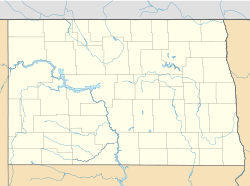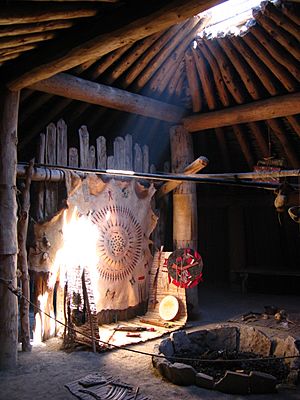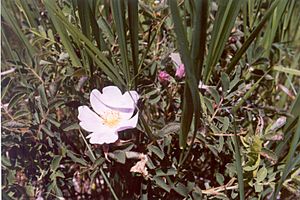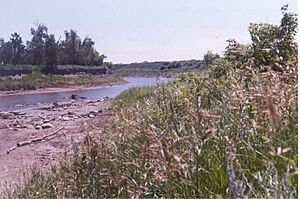Knife River Indian Villages National Historic Site facts for kids
|
Knife River Indian Villages National Historic Site Archeological District
|
|
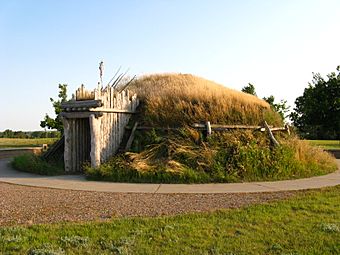
Reconstructed Hidatsa Indian Earthlodge
|
|
| Location | Stanton, North Dakota |
|---|---|
| Area | 1,758 acres (7.11 km2) |
| Visitation | 10,867 (2024) |
| Website | Knife River Indian Villages National Historic Site |
| NRHP reference No. | 74002220 |
Quick facts for kids Significant dates |
|
| Added to NRHP | October 26, 1974 |
| Designated NHS | October 26, 1974 |
The Knife River Indian Villages National Historic Site was created in 1974. It protects the old villages and history of the Hidatsa people. These Native Americans lived on the Northern Plains in North Dakota.
This area was a very important place for trading and farming. Three main villages were located near the Knife River. These villages are known as Hidatsa villages. Their names were Awatixa Xi'e (the lower Hidatsa village), Awatixa, and Big Hidatsa village. Awatixa Xi'e is thought to be the oldest of the three. The Big Hidatsa village was started around the year 1600.
Contents
Exploring the Knife River Area
The Knife River Indian Villages National Historic Site is in central North Dakota. It sits where the Knife River meets the mighty Missouri River. The site is about half a mile north of the town of Stanton, North Dakota. It's about an hour northwest of Bismarck.
You can see beautiful sights along these two rivers. There are wide open plains, tall river bluffs, and forests in the river bottoms. The national park covers both sides of the Knife River. It includes a forested area that stretches along the river.
History of the Villages
Life in the Earth Lodges
At the Knife River Indian Villages, you can still see signs of old homes. These include circular marks from earth-lodge dwellings. There are also storage pits and trails made by travois, which were sleds pulled by animals.
The earth-lodge dwellings look like big round dips in the ground. These homes were quite large, up to 40 feet across and 14 feet high. They were built with wood frames. These frames were covered with layers of willows, then dried grass, and finally about 4 inches of earth. This is why they were called "earth lodges."
Many of these lodges were big enough for two families to live in. The most important horses were kept safe inside a small pen by the door at night. The floor inside was a bit lower than the ground outside. This was because of daily sweeping. A fireplace was in the middle of the lodge. A hole in the roof let the smoke escape. When people left these homes, the walls and roof fell in. This created the circular rims you can still see today.
Sakakawea's Story
Sakakawea (Sacagawea) was a Shoshone woman who lived in one of the Knife River villages. She was captured by another tribe but later joined the Lewis and Clark Expedition. Her presence and her baby son were very important for the safety and success of the explorers.
Sakakawea helped by translating different languages for the group. Also, other Native American tribes saw that a young woman and child were with the explorers. This made them believe the group was not a threat. War parties usually did not bring women and children with them.
Trading and Farming Life
The Knife River Villages were a major center for trading and farming. The Native Americans here acted as middlemen in a huge trading network. This network reached from Minnesota to the Great Plains, the Gulf Coast, and even the Northwest Pacific Coast.
They traded things like furs, guns, and metals such as copper. The Hidatsa and Mandan people also traded corn and other foods. They grew corn, beans, squash, and sunflowers in large gardens. The women of the villages managed these important gardens.
The Smallpox Outbreak
The Knife River villages were thriving until 1837. Then, a terrible sickness called smallpox spread through the area. It caused many people to get sick and die. The population of the villages was cut in half.
After this, the survivors from the Mandan, Hidatsa, and Arikara villages moved north. They started a new village called Like-a-Fishhook.
The smallpox outbreak from 1837 to 1840 was especially devastating for the Mandan people. About 90% of them died. Out of 1,600 Mandan villagers, only 31 survived. The smallpox sickness spread easily through trading. Even with warnings, Native Americans visited trading posts and caught the virus. Once villages were empty, neighboring people sometimes took goods. But they often carried the virus back to their own homes through blankets, horses, and tools.
Nature at Knife River
Plants and Trees of the Park
Hundreds of years ago, when Native Americans lived here, the land looked different. The higher areas were mostly prairie with few trees. The forests along the river bottoms were rich and fertile. Native Americans cleared these fertile areas to grow crops like corn, beans, squash, and sunflowers.
Common trees in the river bottoms included green ash, cottonwood, American elm, and box elder. Smaller trees and shrubs like sandbar willow, red osier dogwood, and buffalo berry were also common.
In 1974, efforts began to restore the park to its original look. Today, the area has native short grass prairies and some non-native grasslands. It also has about 450 km2 (170 acres) of hardwood forest. You can find cultural village sites, wetlands, and sandbars.
Some parts of the forest have changed very little over time. Prairie areas have grasses like wheatgrass, needlegrass, grama, and big bluestem. Many other wildflowers and plants grow there too. Wildlife in the park eats plants like choke cherry, wild plums, buffaloberry, and Juneberry.
Animals and Insects of the Park
The different plant areas in the park are home to many kinds of wildlife. The forests have white-tailed deer, coyotes, beavers, skunks, and ground squirrels.
Many types of birds also live here. Game birds include turkeys, pheasants, Canada geese, and mourning doves. You might spot raptors like owls, red-tailed hawks, bald eagles, and kestrels. Other birds near the rivers include white pelicans, snow geese, and great blue herons. The Missouri and Knife Rivers are home to 26 known types of aquatic mollusks.
Scientists are collecting and studying insect species within the park. Over 200 different types of invertebrates have been found. Common insects include beetles, flies, true bugs, leaf hoppers, and bees, wasps, and ants. Many of these insects are a key food source for the park's wildlife.
Managing Invasive Plants
Like many places, the park works to manage invasive species. These are plants that are not native to the area and can cause problems. Non-native plants first appeared when Native Americans and later settlers cleared forests. Many were brought by accident, but some were planted on purpose.
Examples of these plants include leafy spurge, Canada thistle, and sweet clover. The park has a program to study and track the plants and animals there. This information helps park managers decide how best to control these invasive plants.
Weather at Knife River
Summers at Knife River are usually warm and mostly clear. In July, the average high temperature is about 29 °C (84 °F). The average low is about 14 °C (57 °F). High temperatures rarely go above 34 °C (94 °F).
Winters are cold and mostly cloudy. In January, the average high temperature is about -6 °C (22 °F). The average low is about -15 °C (5 °F). Low temperatures often drop below -18 °C (0 °F). The area gets about 300 mm (12 in) of rain each year. It also gets about 330 mm (13 in) of snow annually.


